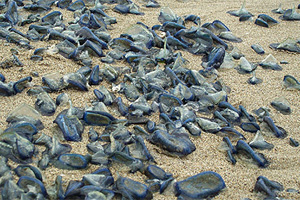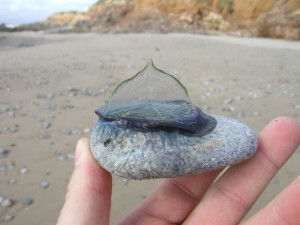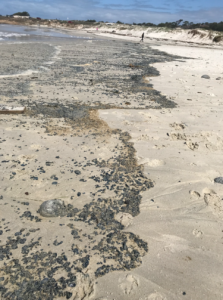
FACTS
- Occasionally, Velella velella wash up in droves on Sanctuary Beaches.
- Though they usually control direction using their sail-shaped form, strong winds sometimes force them onto beaches.
- In the water, their iridescent blue color looks like an oil slick.
- Velella are a food source of the Mola mola, or ocean sunfish.
Occasionally, by-the-wind-sailor jelly fish (Velella velella) wash up in droves. Sanctuary beaches have seen lots of these blue jellies in spring 2002 and April through August, 2003. In 2014, Velella showed up on shores at the end of July and start of August, which is abnormally late for such an event. In April 2015 beaches from Washington state to Ventura, California were covered with Velella that had been blown to shore.
On the surface of the water, large aggregations of these animals look like oil slicks. Once washed ashore, the blue color fades and they look like fields of crumpled cellophane. Velella velella are found around the world.
Their triangular “sail” is angled so that the wind usually keeps them offshore, but when strong winds blow, they lose their ability to “tack” and wind up on our beaches. Within a population, there are individuals whose sails are oriented in different directions. These “mirror image” jellies get pushed in opposite directions by the wind.

The blue-pigmented float is made of gas chambers that are used for buoyancy. Small tentacles hang down from the float and contain stinging cells. Though these jellies are not dangerous to humans, it is recommended to not touch eyes or mouth after handling them. These floating jellies eat fish and invertebrate eggs, as well as copepods, and are eaten by ocean sunfish.


Links to More Information
Velella velella page in the SIMoN Species Database
Jellywatch web site about Velella
More info on Velella velella (PDF from Oregon SeaGrant)
Jellies Zone: see more information and images of the by-the-wind sailor
2014 Scientific American article
2014 CNN video in Oxnard, CA